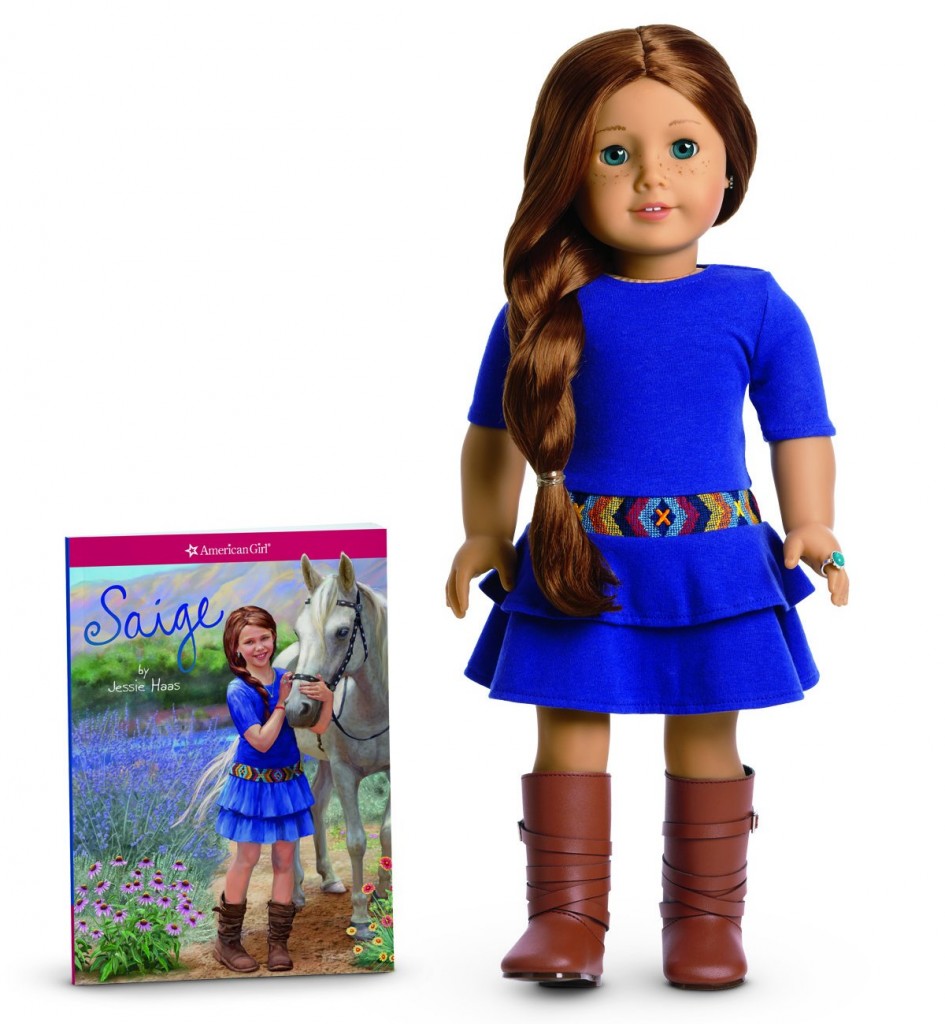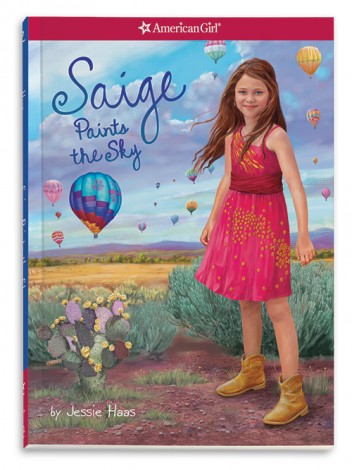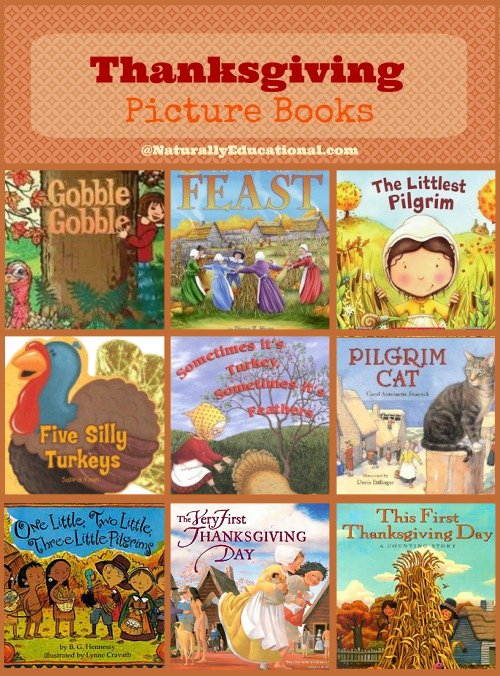In Saige, the first book for the American Girl of the Year for 2013, Saige Copeland, author Jessie Haas shares an inspiring story about a young girl who loves painting and takes a stand for keeping the arts in her school.

In the first book, Saige grows as an artist and as an equestrian, makes a new friend, develops a more mature relationship with a life-long friend, takes on new responsibilities, and helps save the arts in her school. Haas paints a rich Southwest world and a relatable character. Young readers will be inspired to create positive change in their communities, just like Saige.
In conjunction with introducing Saige, American Girl is launching an Elevate the Arts School Grant Contest: Starting January 1, elementary art teachers can enter to win one of thirteen grants totaling $45,000 for their schools’ art programs by submitting a digital image of a hot-air-balloon-themed art project and a written essay that conveys why the arts matter in their schools. Entries must be received via the online form by May 31, 2013.
I had the opportunity to ask Jessie Haas, the author of Saige and Saige Paints the Sky, a few questions about bringing the world of Saige to life, the importance of art in our schools, the bond between animals and children, maintaining friendships as we grow, and young people making a difference.
Thank you for taking the time to answer these questions, Ms. Haas. In Saige, we learn that Saige Copeland is a fourth grade girl from Albuquerque, New Mexico, who loves horses and art. To what extent did you draw on your own experiences and childhood in writing the book?
I grew up loving horses too. My other big love was books, not art, but my younger sister is an artist and horse-lover. So Saige is a lot like both of us. I grew up on a small farm; in the Saige books it’s Mimi, Saige’s grandmother, who has the farm, but Saige is there almost every day, so that rural life is a big part of her world, and another thing we both share.
What research, if any, helped you in creating the texture of Saige’s world?
I’ve had a long-distance love-affair with New Mexico since childhood. The three cultures—Native American, Spanish American and Anglo—and the cowboy culture were what drew me, and I’m a huge fan of some of the writing about New Mexico: Eugene Manlove Rhodes grew up there, and was a cowboy and cattle rustler before becoming a popular Saturday Evening Post author. I love his work, especially Paso Por Aqui. Willa Cather’s Death Comes for the Archbishop is also very beautiful. I reread these old favorites, dipped into travel books and lots of archived photos on-line, and worked closely with Beth Larson, a consultant for the book on art in the schools who lives in an Albuquerque neighborhood very much like Saige’s. Early in my
research I got excited about the International Balloon Fiesta, which is an enormous annual event, and that played a big role in shaping the book—though it created some challenges. Working with real-life events like Balloon Fiesta and the New Mexico school schedule meant creating a calender for the book, to be sure everything happened on time. That was a first for me.
In the book, Saige and her best friend, Tessa, struggle with developing different interests and spending time apart. How can young girls follow their own interests while maintaining old friendships?
That’s one of the big things we all have to learn growing up, and sometimes re-learn a few times as adults. In Saige I drew on issues I had with my own best friend, Pat, who was musical like Tessa, and is a harpist and singer today. We had different interests and those pulled us apart for awhile, but we both love horses and we both laugh at the same things. She loves my books, I love her music, so we bring new things into each other’s lives. I turned to Pat for musical details while writing Saige, which was fun and fitting for the story. So I would say, Keep the channels open. Talk often, even if just to reminisce about the old days when you were third graders. And remember how cool it’s going to be when you’re both successful women—say a great artist and a well-known singer—to say that you’ve been friends since second grade!
Saige develops a special bond with her grandma’s horse, Picasso. How does a relationship with an animal affect a young child?
A good relationship with an animal can be so grounding. It teaches responsibility, sensitivity, all those important things, but I think it’s bigger than that. A connection with animals is very deep in us. We can get so tangled up in other people’s words and opinions, and that’s very confusing, especially when you’re young. With an animal, there’s a chance to have a bond of the heart that’s more pure and simple. And the relationship goes both ways. Many animals have a very different attitude toward children than they do toward adults. Horses in particular will take great care of a young rider, whereas they might be quite challenging to an older rider. So a relationship with kids seems to do something for animals too. I wish we could ask them what that is!
The focus of much of the book is on Saige’s efforts to raise money for the school arts program. Why are the arts so important in our schools?
Young animals, us included, learn by playing, and art is a form of deep play. It teaches you to manipulate your world, it teaches you to try new things and not be afraid of making a mistake, and it teaches self-discipline—all while having fun. I know from personal experience what a big difference that can make. I went through an old-fashioned school in which there was nothing fun about academics. You weren’t allowed to read ahead in the reading book—though I did. You did spelling and grammar, never anything creative. The only really fun classroom time was the half-hour after noon recess when teachers read us stories, chapter by chapter. I remember those stories much more vividly than anything else about those years. I was an avid reader at home, but I in no way connected that pleasure with school work. Then in fifth grade a young substitute teacher introduced us to poetry, and asked us to write poems about things we were interested in. I wrote horse poems, and to my astonishment discovered that it was fun, as much fun as reading.
It shouldn’t have taken till fifth grade to find that out, but thank goodness I did, and I’ve never looked back.
In today’s world, where design is such an important element and music is everywhere, having those subjects in school can make a huge difference in a child’s future options. It’s part of basic literacy. Many children will grow up to work in fields where they need this knowledge, probably in ways we can’t imagine right now. And it’s part of our human heritage that we’d be short-sighted, not to say Scrooge-like, to ignore. Beyond that, there are lots of statistics about how children who have regular art classes in school do better both academically and socially, with better anger and impulse control and higher test scores. The important thing about regular art classes is that all children benefit, not just the self-selected artistic ones. Lots of kids might not naturally gravitate toward art. Some might feel social pressure not to express an interest, or might simply not have the resources for extra-curricular art. But all children need the arts, all children benefit, and so all children should have access as a regular part of school. Plus it immediately changes those bland school walls when the art projects start to go up. Who doesn’t need that?
Saige and her friends organize a fundraiser for the arts. In what ways can young children help make a difference in their world?
When children do something like this—raising money for flood victims or animals in shelters, or volunteering to help those in need—the world pays attention. I’m amazed at the stories American Girl has collected about the kinds of thinks girls have done—from bake sales to craft sales to on-line efforts to volunteering. Kids have power, especially if they work together. I’ve been an activist myself, though I didn’t start until adulthood. As a shy person, it astonished me (and still does) to discover how much easier it is to do public things on behalf of someone else. It’s very freeing to find that out, and the earlier that happens the better.
As an author, you balance a number of threads–Saige’s emotional development, her relationships with other people, her bond with animals, her love of art, and her budding activism. What ties all these stories and ideas together?
What ties the whole story together is love. Saige loves Tessa, art, the animals, her grandmother. Each of these relationships is threatened in some way . Tessa’s new interest in music, and a new friend. No art classes in school. No Mimi at home taking care of the horses—and bringing Mimi’s dog home is an absolute disaster! Then there’s Mimi herself, Saige’s very best friend, injured and afraid that she’s lost her way of life. Saige doesn’t curl up in a ball and give up (though she does have a little cry with her dog). Instead, she works on her friendships, she trains a horse, she produces a show, she paints, and she finds ways to show Mimi the way back to art and the ranch. None of these things happen all at once. Healing a friendship takes lots of small acts, training a horse takes repeated lessons, a painting evolves over many days and many brushstrokes. So I would say two things hold the story together —love and persistence.
What do you hope girls learn, or take away, from reading the book?
I hope girls come away thinking: I want to try that! Painting, or making jewelry out of horsehair, or clicker training a pet, or demonstrating for a good cause, or taking a hot-air balloon ride. I hope they’ll feel that it’s worth it to try things that look difficult at first. And I hope they’ll have fun simply immersing themselves in another person’s world, because that’s the biggest pleasure of reading.



my dad is now in chicago america and i am from qatar i cant go to america i have school so my dad now is there i just want o know more about saige
Best Regards: Noonita
Student
Gulf English School
waiting for replay
Hey fantastic blog! Does running a blog such as
this take a massive amount work? I’ve no knowledge of computer programming but I was hoping to starrt my own blog soon. Anyways, if you have any suggestions or techniques for
new blog owners please share. I understand this iis off subject however I just needed too ask.
Many thanks!
Here iis my weblog: k drewe classic car insurance (http://www.tips-texas.com)
eu quero descobrir onde compra a saige no brasil